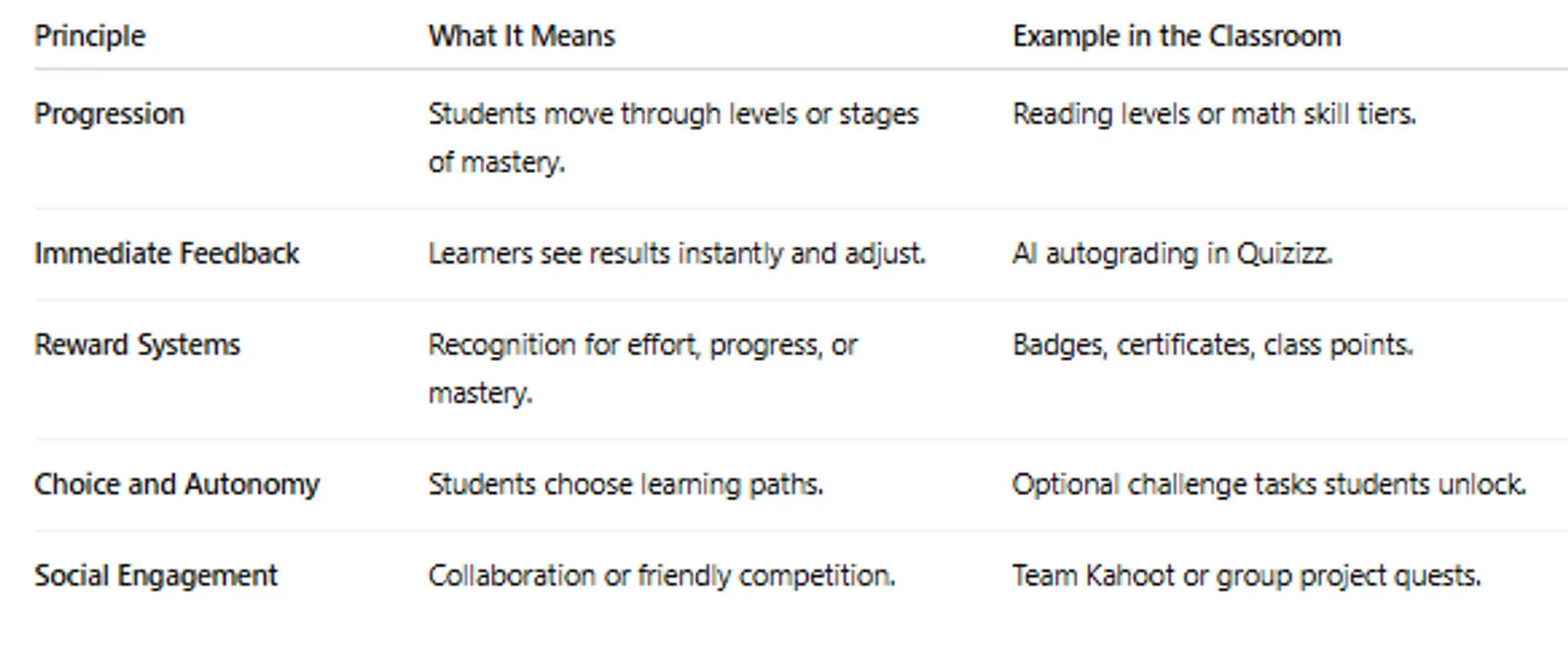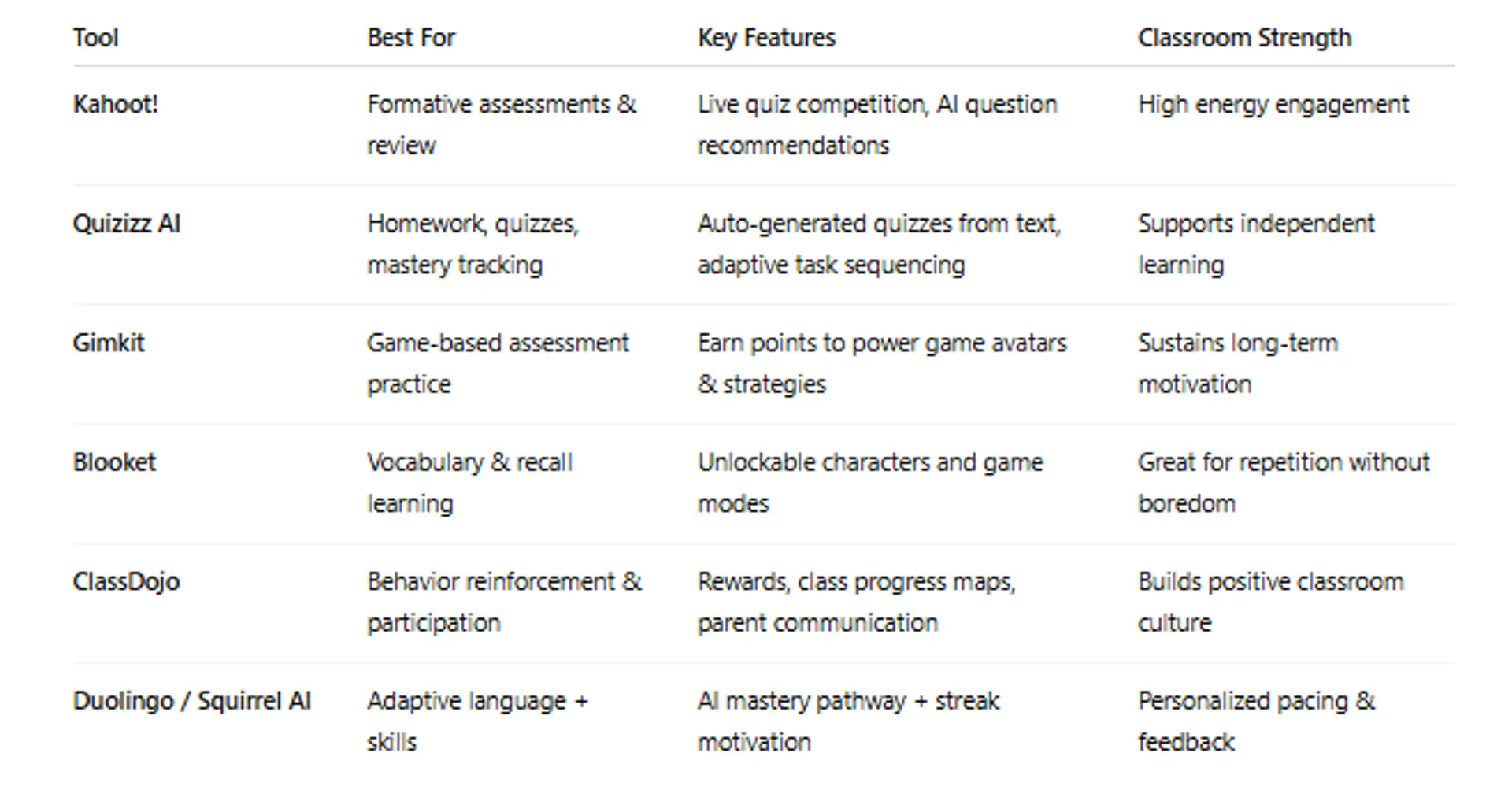

Module 6: AI in Classroom Management & Engagement Lesson 6.3: AI Gamification and Motivation Tools
Module 6: AI in Classroom Management & Engagement
Lesson 6.3: AI Gamification and Motivation Tools
Learning Objectives
By the end of this lesson, educators will be able to:
- Define gamification and distinguish it from game-based learning.
- Explain how AI personalization enhances student motivation and retention.
- Identify and compare leading AI-powered gamification platforms.
- Design gamified learning experiences aligned with curriculum objectives.
- Analyze engagement data generated by AI tools to support differentiated instruction.
- Apply gamification responsibly, ensuring psychological safety and inclusivity.
1.Understanding Gamification in Education
Gamification is the application of game design elements in non-game contexts to motivate participation, engagement, and learning.
Gamification focuses on how students interact with learning, not merely adding games.
Core Principles of Gamification

2. Why Gamification Supports Stronger Learning
Gamification works because it engages emotion, not just cognition.
Benefits Supported by Learning Science

3. The Role of AI in Gamification
AI improves gamification by making learning adaptive:
- Adjusts challenge difficulty based on student performance.
- Provides hints or scaffolding when students struggle.
- Tracks learning progress invisibly in the background.
- Recommends next steps individualized to each learner.
AI Personalization Example
If a student consistently struggles with fractions:
- AI reduces difficulty temporarily,
- Pauses progression,
- Inserts practice tasks,
- And gives instant feedback.
This replaces embarrassment with supported learning.
4. Leading AI Gamification Tools

5. Framework for Designing Gamified Learning Activities
A. Start With Learning Objectives
Gamification must support the curriculum, not distract from it.
Example:
Objective: Students will understand the causes of the American Revolution.
Gamification: “Cause & Effect Quest Map” — unlock each event through research & discussion.
B. Define the Gamified Structure

C. Monitor & Adjust with AI Analytics
AI tools show:
- Which standards students are mastering
- Where they are struggling
- How engaged each learner is
Teachers use this data to:
- Pair peer tutors
- Offer reteaching sessions
- Provide enrichment challenges
6. Example Gamified Activity (Ready to Use)
Subject: Science (Middle or High School)
Lesson Goal: Understand the carbon cycle.
Gamified Task: “Earth Systems Adventure Quest”

Reward System:
Every level completed = 1 “Eco Badge.”
5 badges = “Carbon Cycle Certified Scholar.”
7. Responsible Use & Inclusivity Considerations
Avoid:
- Public leaderboard shaming
- Making winning the main focus
- Punishing failure instead of promoting retrying
Ensure:
- Students can compete against themselves, not always others.
- Achievement is celebrated for effort, not just speed or talent.
Supplementary Resources
What Research Says About Gamification
Personalized learning with the latest AI - Duolingo’s approach to AI
Kahoot! Walkthrough for Teachers
Lesson 6.3 Quiz- AI Gamification and Motivation Tools
You must score at least 70% to pass.
This quiz counts toward your certification progress.
Click here for Quiz 6.3:
Conclusion
AI-enabled gamification transforms learning into an interactive, student-driven journey. When aligned with curriculum objectives, gamification increases motivation, strengthens retention, and builds a supportive classroom culture. Educators remain essential in guiding reflection, ensuring fairness, and reinforcing the value of learning beyond rewards.
Gamification isn’t about making school a game — it’s about making learning meaningful, engaging, and personalized.
Next and Previous Lesson
Next: 6.4: AI for Class Productivity & Communication
Previous: Lesson 6.2: Automating Admin Tasks (Attendance, Emails, Scheduling, and Grading Reports)
AI for Educators: Personalized Learning & Content Creation
Related Posts
© 2025 Invastor. All Rights Reserved

User Comments